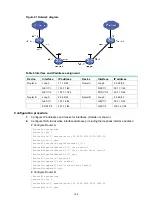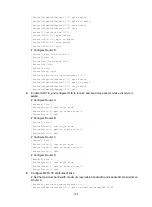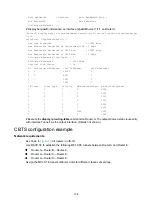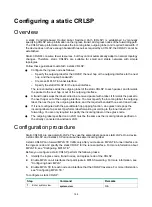
162
Auto Bandwidth : - Auto Bandwidth Freq : -
Min Bandwidth : - Max Bandwidth : -
Collected Bandwidth : - Service-Class : 3
[RouterA]display mpls te tunnel-interface Tunnel 3
Tunnel Name : Tunnel 3
Tunnel State : Up (Main CRLSP up)
Tunnel Attributes :
LSP ID : 17418 Tunnel ID : 3
Admin State : Normal
Ingress LSR ID : 10.1.1.1 Egress LSR ID : 40.1.1.1
Signaling : RSVP-TE Static CRLSP Name : -
Static SRLSP Name : main3/-
Resv Style : -
Tunnel mode : -
Reverse-LSP name : -
Reverse-LSP LSR ID : - Reverse-LSP Tunnel ID: -
Class Type : - Tunnel Bandwidth : -
Reserved Bandwidth : -
Setup Priority : 0 Holding Priority : 0
Affinity Attr/Mask : -/-
Explicit Path : -
Backup Explicit Path : -
Metric Type : TE
Record Route : - Record Label : -
FRR Flag : - Bandwidth Protection : -
Backup Bandwidth Flag: - Backup Bandwidth Type: -
Backup Bandwidth : -
Bypass Tunnel : - Auto Created : -
Route Pinning : -
Retry Limit : 3 Retry Interval : 2 sec
Reoptimization : - Reoptimization Freq : -
Backup Type : - Backup LSP ID : -
Auto Bandwidth : - Auto Bandwidth Freq : -
Min Bandwidth : - Max Bandwidth : -
Collected Bandwidth : - Service-Class : 6
The
Service-Class
fields show that the CoS values of Tunnel 2 and Tunnel 3 are 3 and 6,
respectively. According to the QoS policy, traffic arrives at GigabitEthernet 1/1/4 of Router A is
assigned CoS 3. So CBTS uses Tunnel 2 to forward the traffic.
Troubleshooting MPLS TE
No TE LSA generated
Symptom
OSPF TE is configured but no TE LSAs can be generated to describe MPLS TE attributes.
















































